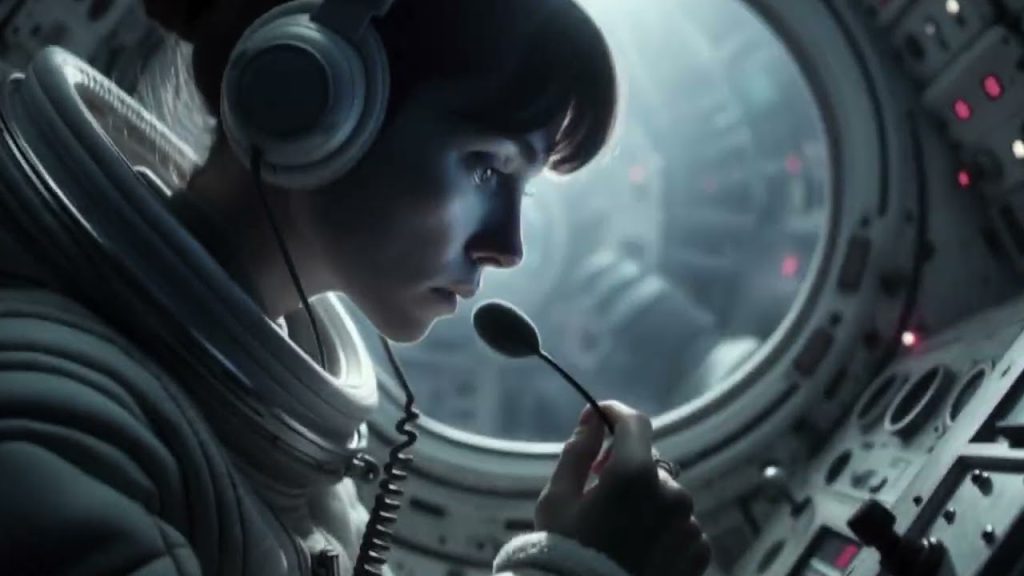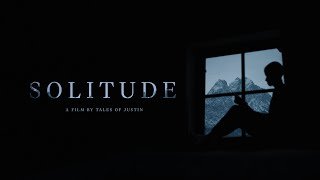🎬 Film Title: Solitude (2025)
Genre: Horror / Psychological Thriller / Survival
Language: English
Lead Cast: Katharine King So, Jonathan Rosenthal
Setting: Remote forest; survival reality-show environment
Tone: Bleak, chilling, introspective
🧠 What Is Solitude Really About?
At its surface, Solitude is a found-footage-style horror-thriller: a contestant named Kara takes part in a high-stakes survival reality TV show, voluntarily isolating herself in a remote forest to win a huge cash prize.
But Solitude is much more than a survival game. It’s a haunting exploration of the human mind under pressure, a critique of voyeuristic entertainment, and a metaphor for how trauma, grief, and unresolved guilt can manifest as monsters—both literal and psychological.
🎥 Story Breakdown (Spoiler-Free First)
Premise:
Kara, a driven and emotionally damaged woman, signs up for a new extreme survival reality show. The rules are simple:
- Live alone in the forest for 100 days
- Film yourself entirely with provided gear
- No contact with the outside world
- The last person standing wins
What begins as a test of endurance turns into something unholy, as Kara begins to hear sounds, see figures in the trees, and suspect that she is being hunted—not just by animals, but something much older and darker.
As days pass, her isolation erodes her sense of reality. The camera, which was meant to document survival, now captures descent.
🧬 Deeper Themes and Symbolism
1. The Horror of Isolation
Isolation is more than a physical state in Solitude—it is a psychological breakdown. Kara’s mind, burdened by past trauma, starts to betray her. The absence of other humans becomes a vacuum that pulls in hallucinations, paranoia, and primal fear.
This is not survival against nature—it’s survival against the self.
2. Media as the Monster
Kara’s every move is filmed, and the very concept of the show is a grotesque form of entertainment—watching people unravel alone for amusement.
This mirrors real-world critiques of:
- Exploitative reality TV
- Trauma turned into spectacle
- The voyeurism of watching people suffer from a distance
The cameras in Solitude are not Kara’s tool—they are her prison.
3. The Wendigo as Metaphor
Yes, a supernatural presence stalks the forest. The film borrows from Wendigo mythology—a spirit associated with cannibalism, winter, greed, and madness. But the creature is never shown clearly, which adds to the ambiguity:
Is the Wendigo real?
Or is it Kara’s guilt and hunger, personified?
The Wendigo represents:
- Her growing desperation
- Her detachment from humanity
- The “devouring” effect of trauma and loneliness
The deeper she isolates, the closer she comes to becoming the thing she fears.
4. Feminine Trauma and Survival
Kara is not a generic “final girl.” She has a backstory that unfolds in fragments: a history of loss, emotional neglect, and shame. The solitude forces her to confront these shadows. The real terror is not in the forest—but within her.
She’s a woman trying to rebuild herself by proving strength in solitude, but discovers that true survival may require connection, vulnerability, and confronting pain.
🔍 Narrative Devices and Techniques
Found Footage + Meta-Layers
The film uses found-footage aesthetics but blends them with meta-horror: Kara talks to the camera, breaks down in front of it, and at times even pleads with the audience—but there is no audience watching her, only us.
This creates a chilling intimacy. We are not just viewers—we become complicit observers, watching a person psychologically collapse in real time.
Sound Design as Psychological Terror
Sound is Kara’s enemy.
- Whispering winds that sound like voices
- Branches snapping like footsteps
- Her own breathing looped and distorted by the camera
Silence becomes louder than screams.
Ambiguous Reality
The longer Kara is isolated, the more the film blurs what is real and what is imagined. Is the Wendigo hunting her? Is there another contestant? Or is it all a projection of her unraveling mind?
By the time the climax hits, reality has fully collapsed, and the viewer is left to interpret what happened—and what was in Kara’s head all along.
💔 Emotional Core: The Monster Inside
The final message is grim but powerful:
“The longer you live in silence, the more you hear what you’ve buried.”
Kara’s descent is not caused by the forest—but by what she brought into it. Her trauma, her guilt, and her desperation for redemption all take shape as phantoms in solitude.
By the end, she no longer fears dying alone—she fears living as something else.
🎭 Performance & Acting
Katharine King So carries the entire film on her shoulders. Her portrayal is raw, fractured, and deeply human. She transitions from composed to broken, from determined to terrified, with brutal honesty. Her performance anchors the film’s realism even when the horror turns surreal.
🩸 Ending (Spoiler-Free Reflection)
The film ends not with resolution, but with devastating ambiguity. Kara’s final state—physical and mental—is left unclear. But what is clear is the emotional truth: that solitude doesn’t purify—it consumes.
There is no winner. Only a question:
“When we are truly alone, who do we become?”
🎬 Solitude (2025) – Summary
🌲 ACT ONE: The Game Begins
Kara, a 30-something woman with a hardened exterior and haunted eyes, signs up for an experimental, solo survival reality show. The rules are simple:
-
Survive alone in the forest for 100 days
-
No contact with others
-
Document everything with self-operated cameras
-
The last contestant standing wins a life-changing cash prize
Kara seems prepared—physically strong, mentally composed, emotionally distant. But something about her feels brittle, as if she’s not just there to win, but to run from something.
As she sets up camp, logs her days on camera, and follows routine survival strategies, the tone is tense but calm. We sense that Kara has trained for this, but her eyes betray a simmering grief.
Small things begin to feel off. She hears strange noises at night. Trees seem to shift. Items move slightly from where she left them. But she dismisses these as the tricks of solitude.
🌑 ACT TWO: Isolation Tightens
Days pass. The forest grows colder, darker, quieter. Kara begins to fray—not from hunger or physical pain—but from absolute isolation. She talks to the camera like a friend, then begins arguing with it, as if it were a person.
We start seeing flashes of her past:
-
A hospital hallway
-
A child’s voice calling “Mommy”
-
A shadowed figure holding her hand and then letting go
Kara begins to cry in her sleep. She wakes screaming.
Her food runs low. She begins to hallucinate. One night, she sees a figure just beyond the treeline—tall, emaciated, with glowing eyes. It disappears.
Is it a hallucination? Another contestant? Or something worse?
She finds animal bones arranged in patterns near her tent. This is no longer just survival—it’s a hunt.
🧠 ACT THREE: The Descent
Kara’s camera logs become desperate. She stops recording meals or strategies and begins speaking confessions into the lens:
“I didn’t mean for it to happen… I wasn’t ready to be alone.”
The flashbacks sharpen:
-
A car crash
-
A child in the back seat
-
Kara crawling from the wreck, her child lifeless
This is the root of her solitude—not adventure, not money. Grief. Guilt. Escape.
She came to the forest to disappear.
But something in the woods won’t let her. It mirrors her pain, feeds on it. Kara begins to see the figure more clearly now—a Wendigo-like creature, skeletal, with antlers, mimicking the cries of her lost child.
🔥 ACT FOUR: The Confrontation
Starving, frostbitten, and almost mute from fear, Kara begins to unravel. She sets up a fire and surrounds it with her cameras—her only witnesses. She begs the forest to take her. She tries to burn the tapes, but they refuse to catch flame.
She runs. The creature chases her—whether real or not, we don’t know. She ends up in the same spot where she first set camp, implying she never truly escaped.
Then, in a chilling, silent scene, she looks straight into the lens and whispers:
“It’s not solitude if something’s always watching.”
⚰️ ACT FIVE: The Ending
The screen cuts to static.
We shift to a broadcast room weeks later, where producers sit stunned, watching the footage Kara recorded. All contestants have dropped out or been disqualified. Only Kara remains unaccounted for.
A final tape plays.
It shows Kara walking into the woods, her back to the camera, barefoot in the snow, whispering to the darkness:
“I hear you now.”
She vanishes behind the trees.
No body is ever found.
🔍 Interpretation of the Ending
Was the creature real? Possibly. But more likely:
-
The Wendigo was the manifestation of Kara’s grief and self-blame.
-
The forest became a psychological echo chamber, reflecting her trauma back at her.
-
The “game” was never about survival. It was about what happens when a person is left alone with nothing but memory, regret, and the need to be punished.
The final implication is this: Kara never escaped the crash emotionally, and in solitude, she became the monster that haunted her.
💡 Final Message
“Solitude is a mirror. And some mirrors don’t forgive.”
Solitude (2025) is not a monster movie in the traditional sense. It’s a slow, suffocating unraveling of a broken mind seeking peace in silence, only to find that silence has a voice—and it screams your name.

